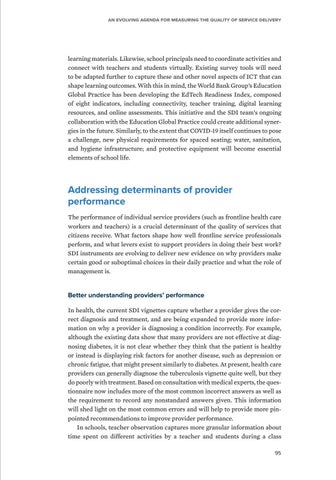An evolving agenda for measuring the quality of service delivery
learning materials. Likewise, school principals need to coordinate activities and connect with teachers and students virtually. Existing survey tools will need to be adapted further to capture these and other novel aspects of ICT that can shape learning outcomes. With this in mind, the World Bank Group’s Education Global Practice has been developing the EdTech Readiness Index, composed of eight indicators, including connectivity, teacher training, digital learning resources, and online assessments. This initiative and the SDI team’s ongoing collaboration with the Education Global Practice could create additional synergies in the future. Similarly, to the extent that COVID-19 itself continues to pose a challenge, new physical requirements for spaced seating; water, sanitation, and hygiene infrastructure; and protective equipment will become essential elements of school life.
Addressing determinants of provider performance The performance of individual service providers (such as frontline health care workers and teachers) is a crucial determinant of the quality of services that citizens receive. What factors shape how well frontline service professionals perform, and what levers exist to support providers in doing their best work? SDI instruments are evolving to deliver new evidence on why providers make certain good or suboptimal choices in their daily practice and what the role of management is.
Better understanding providers’ performance In health, the current SDI vignettes capture whether a provider gives the correct diagnosis and treatment, and are being expanded to provide more information on why a provider is diagnosing a condition incorrectly. For example, although the existing data show that many providers are not effective at diagnosing diabetes, it is not clear whether they think that the patient is healthy or instead is displaying risk factors for another disease, such as depression or chronic fatigue, that might present similarly to diabetes. At present, health care providers can generally diagnose the tuberculosis vignette quite well, but they do poorly with treatment. Based on consultation with medical experts, the questionnaire now includes more of the most common incorrect answers as well as the requirement to record any nonstandard answers given. This information will shed light on the most common errors and will help to provide more pinpointed recommendations to improve provider performance. In schools, teacher observation captures more granular information about time spent on different activities by a teacher and students during a class 95


